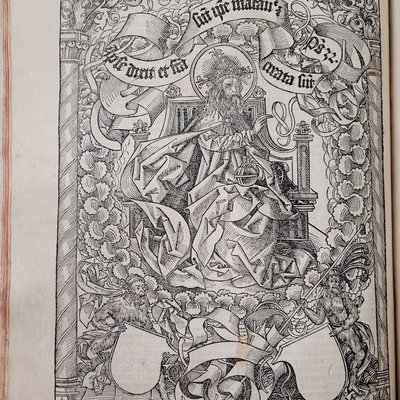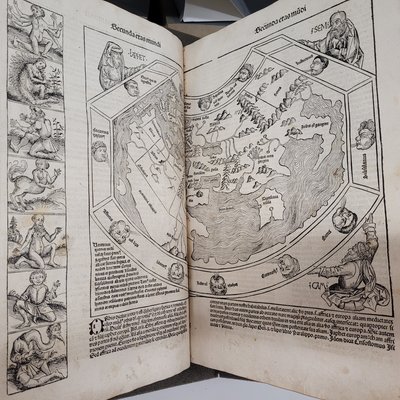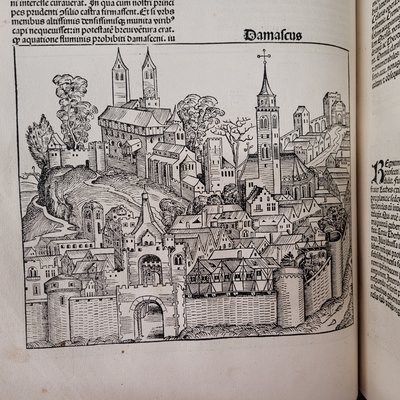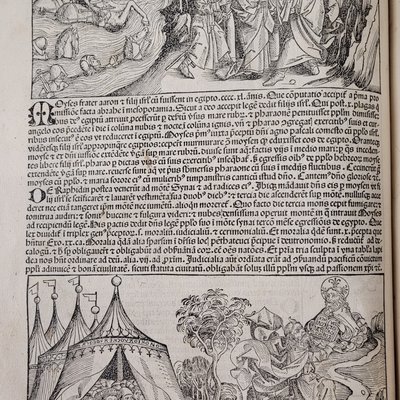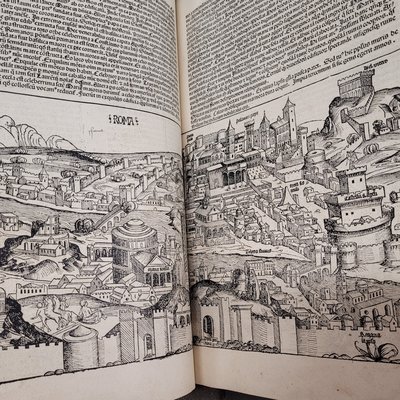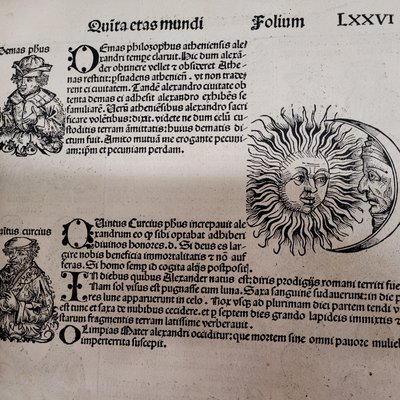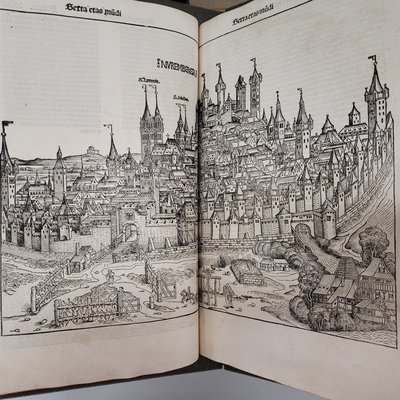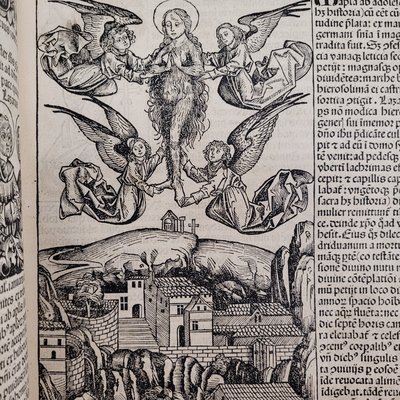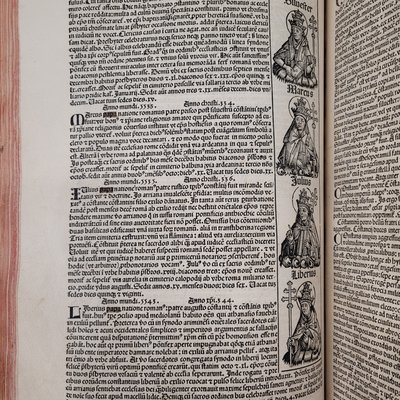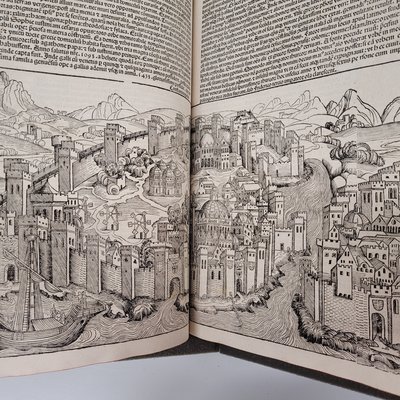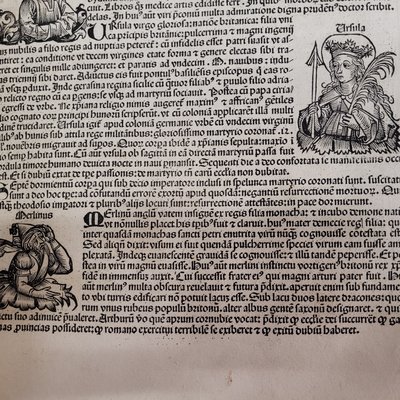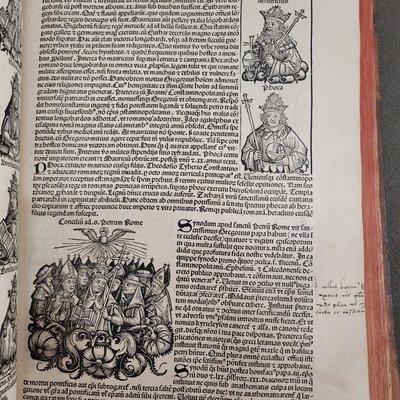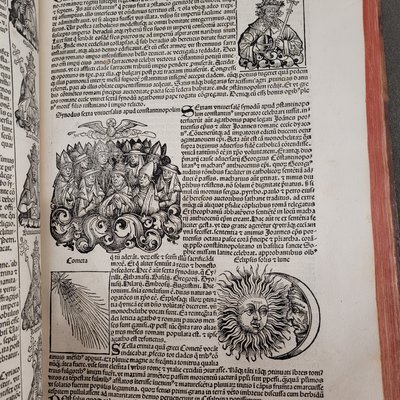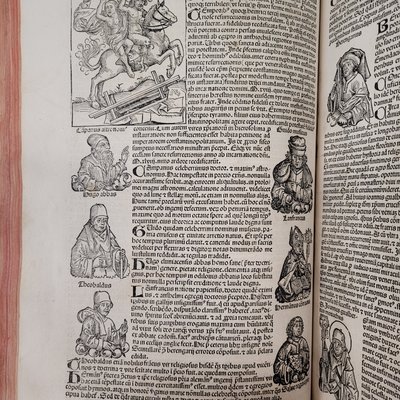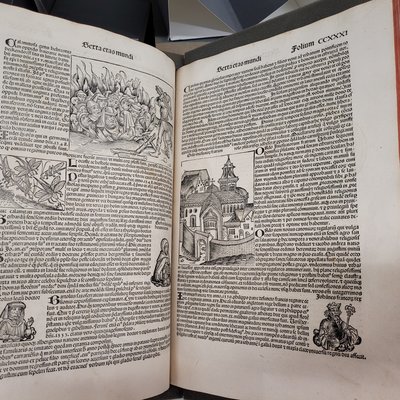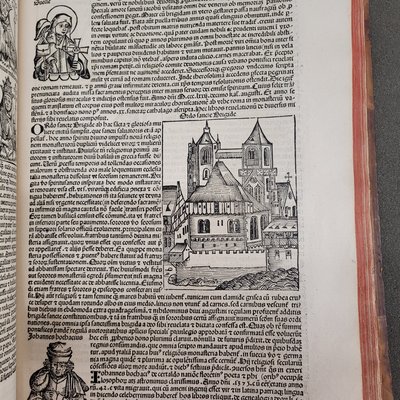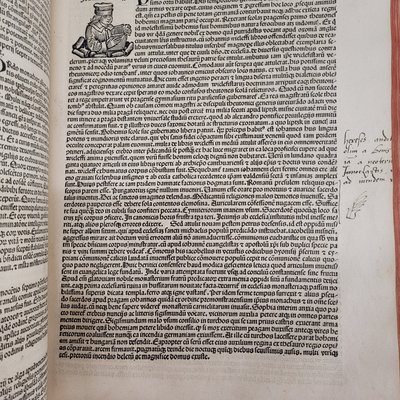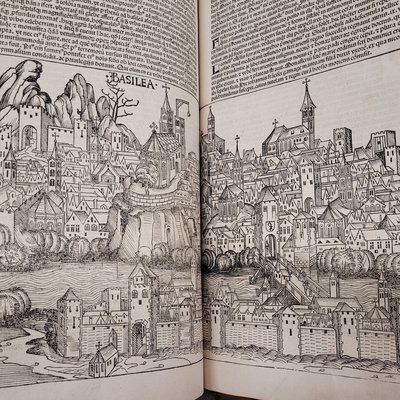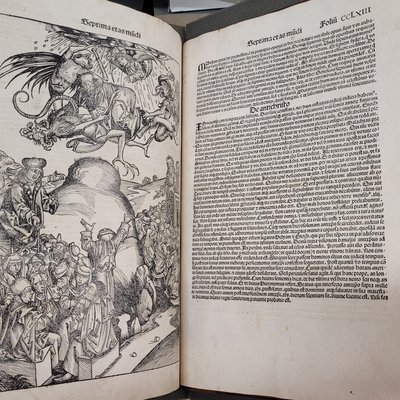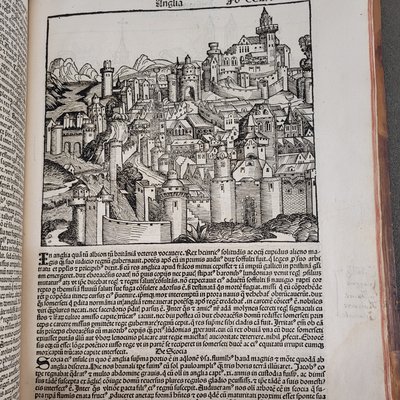December 2022
Our last book of the month for 2022 is the so-called Nuremberg Chronicle from 1493. Despite its early date, it is certainly not a rare book. The Incunabula Short-Title Catalogue lists 858 holding institutions, some of which hold multiple copies. It is, however, one of those books you can keep coming back to and be surprised by details you had not seen before.
This large and heavy volume (over 600 pages measuring approx. 47cm x 32cm) is a Christian history of the world, the first one ‘written in Germany from a humanist and scholarly perspective’ (Mosurinjohn & Ascough, p. 441). The wealthy Nuremberg merchants Sebald Schreyer (1446-1520) and Sebastian Kammermeister (1446-1503) commissioned Hartmann Schedel (1440-1514), a physician, humanist and historian from Nuremberg, with the project. The woodcut illustrations were supplied by Michael Wolgemut (1434-1519) and Wilhelm Pleydenwurff (b. 1460), also from Nuremberg. The Latin edition was printed and published by Anton Koberger (c. 1440/1445-1513) in 1493. It was followed by a German translation in the same year. With around 1,500 copies of the Latin and between 700 and 1,000 copies of the German edition printed, it had one of the largest print runs among the earliest printed books.
Schedel’s text was combined with the over 1,800 illustrations made from over 650 woodcuts to great effect. Indeed, the Nuremberg Chronicle constitutes a significant development in the history of the book for this very reason. Because Michael Wolgemut counted none other than Albrecht Dürer among his apprentices between 1486 and 1489, scholars are debating whether (and what) Dürer may have had contributed to their design and/or execution.
The majority of illustrations are little “portraits”. These represent Biblical men and women, monarchs, popes as well as famous theologians, philosophers, writers, a noticeable number of physicians (not surprising, considering Schedel’s own profession), and other notable men and women (though mostly men) throughout history up to the mid-/late 15th century. The vast majority of the people illustrated are dressed in contemporary Renaissance clothes regardless of when or where they had lived.
Centre-stage take the beautiful, often large-scale illustrations of cities. Nuremberg itself takes pride of place, spread out over two pages it is the only illustration of a city not surrounded by text. Most cities have a tendency to look very much like Renaissance continental European cities regardless of their geography or the historical time to which they are connected. This creates a uniform appearance it can be difficult to identify cities without their caption. There are some noticeable exceptions, however. Rome, for example, is certainly easy to identify. It is not at all clear, however, which English city is represented under the heading Anglia ‘England’. Is it supposed to be London?
The Nuremberg Chronicle is not without controversies. In its visual and textual content appears the misogynistic and Anti-Semitic attitude of its time. The illustration of the witch of Berkeley, for instance, ‘helped popularize the link between […] witchcraft and the devil’ (Kenney & Tancheva) en route to the height of the European witch-hunts, which took place not in the ‘dark’ Middle Ages but between 1550 and 1650. The illustration is so much larger than the four lines that outline the legend; it is, in fact, the largest illustration on that page. By comparison, the illustration of the wizard Merlin is almost dwarfed by the large paragraph dedicated to him. It is also noteworthy that in contrast to the female witch, the male wizard is depicted positively ‘normal’ considering his human-demonic parentage discussed in the text for those skilled in Latin.
Even clearer is the Anti-Semitic thread that runs through the volume in the description and depiction of members of the Jewish faith after the birth of Christ. The Jewish people are consistently represented in a negative light, culminating with a depiction of the centuries-old false and absurd accusation that those of Jewish faith carried out ritual murders on Christian children: ‘[…] in Schedel’s world chronicle, post-biblical Jews kill; desecrate images and the Eucharist poison wells and springs; and convent, but then revert, to Judaism. In return, they are expelled, burned, plundered, and killed. […] The Jews of Christian chroniclers are not the Jews Christians actually encountered every day as their neighbors, with whom they shared towns, neighborhoods, even homes. These were dangerous, demonic figures, enemies who needed to be contained and punished’ (Teter, p. 50). The texts next to depictions of Jewish people being burned take up retrospective accusations to “justify” the burning after the fact. The phenomenon of “fake news” is certainly not a recent development!
St John’s copy of the Nuremberg Chronicle has some annotations and ownership inscriptions. Most notably, someone has diligently gone through the copy trying to black out all occurrences of the word papa ‘pope’. Unfortunately, none of the early owners of this volume had it hand-coloured, as like some other owners. One of the first owners of St John’s copy of Chaucer’s Canterbury Tales printed by William Caxton in 1483, for instance, had the volume’s woodcut illustrations hand coloured. Interestingly, with the Nuremberg Chronicle is obvious that the publisher expected a degree of personalisation. The first woodcut, the Creator, includes two shields for owners to insert their coat of arms or other marks of ownership.
References:
Monurinjohn, Sharday C., and Richard S. Ascough, ‘The Nuremberg Chronicle: Art, Artifact and the End of the World’, Queen’s Quarterly 127:3(2020), 438-59.
‘Nuremberg Chronicle’, in Wikipedia at https://en.wikipedia.org/wiki/Nuremberg_Chronicle [accessed 29/11/2022]
‘Schedel, Hartmann, Librar chronicarum’ in Incunabula Short Title Catalogue at https://data.cerl.org/istc/is00307000 [accessed 25/11/2022]
Teter, Magda, ‘Blood Libel, a Lie and Its Legacies’ in Whose Middle Ages? Teachable Moments for an Ill-Used Past, ed. Andew Albin et al. (New York: Fordham University Press, 2019), pp. 45-54.
Kenney, Anne, and Kornelia Tancheva, The World Bewitch’d: Visions of Witchcraft from the Cornell Collections at https://rmc.library.cornell.edu/witchcraft/exhibition/what/roots.html#modalClosed [access 29/11/2022]
